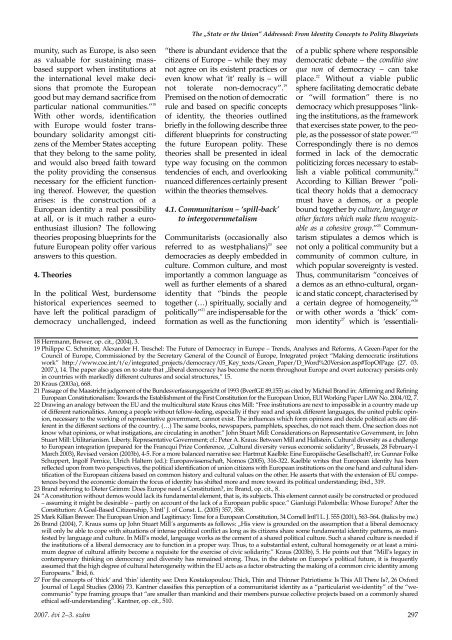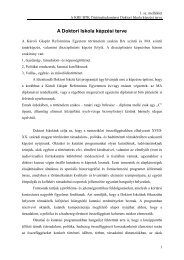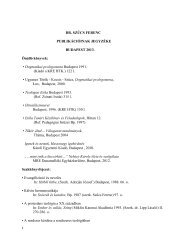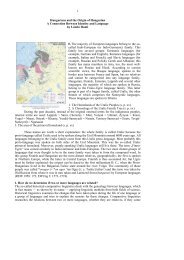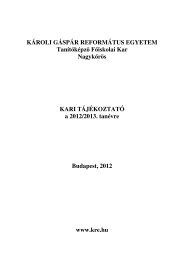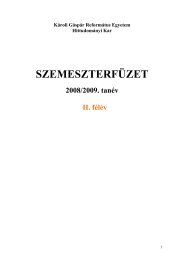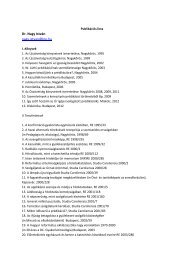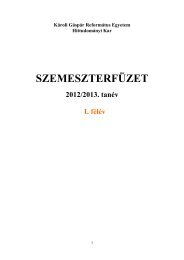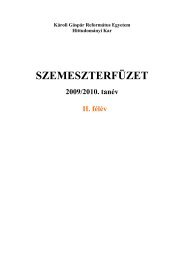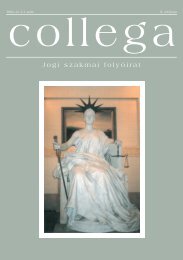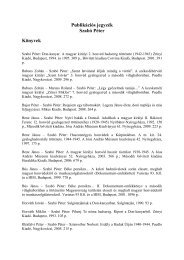collega - Károli Gáspár Református Egyetem
collega - Károli Gáspár Református Egyetem
collega - Károli Gáspár Református Egyetem
You also want an ePaper? Increase the reach of your titles
YUMPU automatically turns print PDFs into web optimized ePapers that Google loves.
The „State or the Union” Addressed: From Identity Concepts to Polity Blueprints<br />
munity, such as Europe, is also seen<br />
as valuable for sustaining massbased<br />
support when institutions at<br />
the international level make decisions<br />
that promote the European<br />
good but may demand sacrifice from<br />
particular national communities.” 18<br />
With other words, identification<br />
with Europe would foster transboundary<br />
solidarity amongst citizens<br />
of the Member States accepting<br />
that they belong to the same polity,<br />
and would also breed faith toward<br />
the polity providing the consensus<br />
necessary for the efficient functioning<br />
thereof. However, the question<br />
arises: is the construction of a<br />
European identity a real possibility<br />
at all, or is it much rather a euroenthusiast<br />
illusion? The following<br />
theories proposing blueprints for the<br />
future European polity offer various<br />
answers to this question.<br />
4. Theories<br />
In the political West, burdensome<br />
historical experiences seemed to<br />
have left the political paradigm of<br />
democracy unchallenged, indeed<br />
“there is abundant evidence that the<br />
citizens of Europe – while they may<br />
not agree on its existent practices or<br />
even know what ‘it’ really is – will<br />
not tolerate non-democracy”. 19<br />
Premised on the notion of democratic<br />
rule and based on specific concepts<br />
of identity, the theories outlined<br />
briefly in the following describe three<br />
different blueprints for constructing<br />
the future European polity. These<br />
theories shall be presented in ideal<br />
type way focusing on the common<br />
tendencies of each, and overlooking<br />
nuanced differences certainly present<br />
within the theories themselves.<br />
4.1. Communitarism – ‘spill-back’<br />
to intergovernmetalism<br />
Communitarists (occasionally also<br />
referred to as westphalians) 20<br />
see<br />
democracies as deeply embedded in<br />
culture. Common culture, and most<br />
importantly a common language as<br />
well as further elements of a shared<br />
identity that “binds the people<br />
together (…) spiritually, socially and<br />
politically” 21 are indispensable for the<br />
formation as well as the functioning<br />
of a public sphere where responsible<br />
democratic debate – the conditio sine<br />
qua non of democracy – can take<br />
place. 22<br />
Without a viable public<br />
sphere facilitating democratic debate<br />
or “will formation” there is no<br />
democracy which presupposes “linking<br />
the institutions, as the framework<br />
that exercises state power, to the people,<br />
as the possessor of state power.” 23<br />
Correspondingly there is no demos<br />
formed in lack of the democratic<br />
politicizing forces necessary to establish<br />
a viable political community. 24<br />
According to Killian Brewer “political<br />
theory holds that a democracy<br />
must have a demos, or a people<br />
bound together by culture, language or<br />
other factors which make them recognizable<br />
as a cohesive group.” 25<br />
Communtarism<br />
stipulates a demos which is<br />
not only a political community but a<br />
community of common culture, in<br />
which popular sovereignty is vested.<br />
Thus, communitarism “conceives of<br />
a demos as an ethno-cultural, organic<br />
and static concept, characterised by<br />
a certain degree of homogeneity,” 26<br />
or with other words a ‘thick’ common<br />
identity 27<br />
which is ‘essentiali-<br />
18 Herrmann, Brewer, op. cit., (2004), 3.<br />
19 Philippe C. Schmitter, Alexander H. Treschel: The Future of Democracy in Europe – Trends, Analyses and Reforms, A Green-Paper for the<br />
Council of Europe, Commissioned by the Secretary General of the Council of Europe, Integrated project “Making democratic institutions<br />
work” http://www.coe.int/t/e/integrated_projects/democracy/05_Key_texts/Green_Paper/D_Word%20Version.asp#TopOfPage (27. 03.<br />
2007.), 14. The paper also goes on to state that „liberal democracy has become the norm throughout Europe and overt autocracy persists only<br />
in countries with markedly different cultures and social structures,” 15.<br />
20 Kraus (2003a), 668.<br />
21 Passage of the Maastricht judgement of the Bundesverfassungsgericht of 1993 (BverfGE 89,155) as cited by Michiel Brand in: Affirming and Refining<br />
European Constitutionalism: Towards the Establishment of the First Constitution for the European Union, EUI Working Paper LAW No. 2004/02, 7.<br />
22 Drawing an analogy between the EU and the multicultural state Kraus cites Mill: “Free institutions are next to impossible in a country made up<br />
of different nationalities. Among a people without fellow-feeling, especially if they read and speak different languages, the united public opinion,<br />
necessary to the working of representative government, cannot exist. The influences which form opinions and decide political acts are different<br />
in the different sections of the country. (…) The same books, newspapers, pamphlets, speeches, do not reach them. One section does not<br />
know what opinions, or what instigations, are circulating in another.” John Stuart Mill: Considerations on Representative Government, in: John<br />
Stuart Mill: Utilitarianism. Liberty. Representative Government; cf.: Peter A. Kraus: Between Mill and Hallstein. Cultural diversity as a challenge<br />
to European integration (prepared for the Francqui Prize Conference, „Cultural diversity versus economic solidarity”, Brussels, 28 February-1<br />
March 2003), Revised version (2003b), 4-5. For a more balanced narrative see: Hartmut Kaelble: Eine Europäische Gesellschaft?, in: Gunnar Folke<br />
Schuppert, Ingolf Pernice, Ulrich Haltern (ed.): Europawissenschaft, Nomos (2005), 316-322. Kaelble writes that European identity has been<br />
reflected upon from two perspectives, the political identification of union citizens with European institutions on the one hand and cultural identification<br />
of the European citizens based on common history and cultural values on the other. He asserts that with the extension of EU competences<br />
beyond the economic domain the focus of identity has shifted more and more toward its political understanding; ibid., 319.<br />
23 Brand referring to Dieter Grimm: Does Europe need a Constitution?, in: Brand, op. cit., 8.<br />
24 “A constitution without demos would lack its fundamental element, that is, its subjects. This element cannot easily be constructed or produced<br />
– assuming it might be desirable – partly on account of the lack of a European public space.” Gianluigi Palombella: Whose Europe? After the<br />
Constitution: A Goal-Based Citizenship, 3 Intl’ J. of Const. L. (2005) 357, 358.<br />
25 Mark Killian Brewer: The European Union and Legitimacy: Time for a European Constitution, 34 Cornell Intl’l L. J. 555 (2001), 563–564. (Italics by me.)<br />
26 Brand (2004), 7. Kraus sums up John Stuart Mill´s arguments as follows: „His view is grounded on the assumption that a liberal democracy<br />
will only be able to cope with situations of intense political conflict as long as its citizens share some fundamental identity patterns, as manifested<br />
by language and culture. In Mill’s model, language works as the cement of a shared political culture. Such a shared culture is needed if<br />
the institutions of a liberal democracy are to function in a proper way. Thus, to a substantial extent, cultural homogeneity or at least a minimum<br />
degree of cultural affinity become a requisite for the exercise of civic solidarity.” Kraus (2003b), 5. He points out that “Mill’s legacy in<br />
contemporary thinking on democracy and diversity has remained strong. Thus, in the debate on Europe’s political future, it is frequently<br />
assumed that the high degree of cultural heterogeneity within the EU acts as a factor obstructing the making of a common civic identity among<br />
Europeans.” Ibid, 6.<br />
27 For the concepts of ‘thick’ and ‘thin’ identity see: Dora Kostakopoulou: Thick, Thin and Thinner Patriotisms: Is This All There Is?, 26 Oxford<br />
Journal of Legal Studies (2006) 73. Kantner classifies this perception of a communitarist identity as a “particularist we-identity” of the “wecommunio”<br />
type framing groups that “are smaller than mankind and their members pursue collective projects based on a commonly shared<br />
ethical self-understanding”. Kantner, op. cit., 510.<br />
2007. évi 2–3. szám<br />
297


